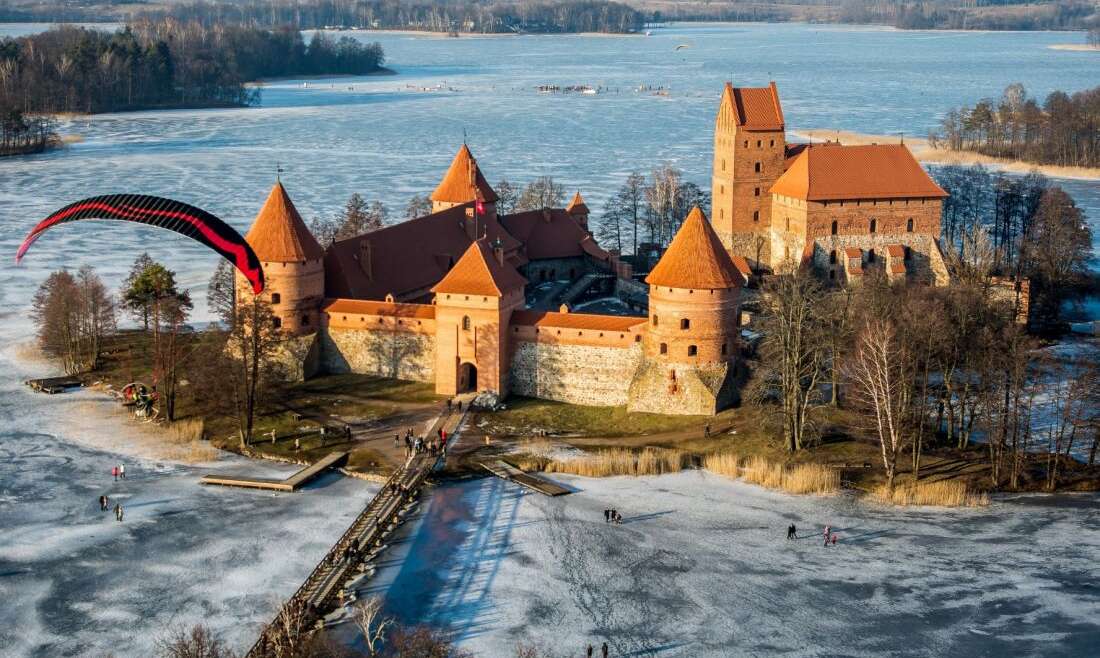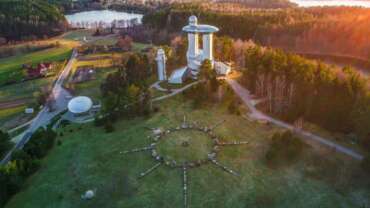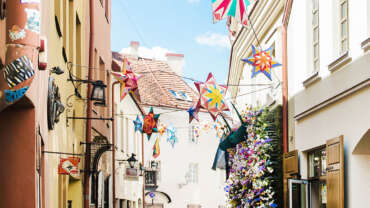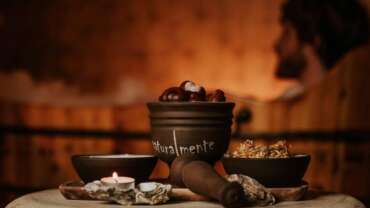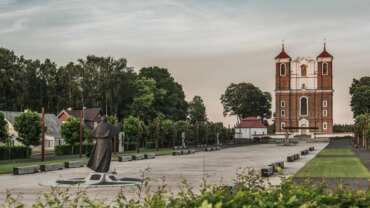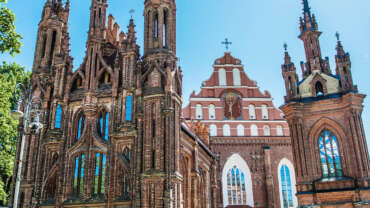Popular Sites in Lithuania
There are so many popular sites in Lithuania. And you definitely have to see them all! In front of the Cathedral Bell Tower in the most important square in the Lithuanian capital of Vilnius, there is something called the Stebuklas (“Miracle”) Tile. Stand on it, spin around three times, and come up with the most beautiful thing you would like to see in Lithuania.
The capital – Vilnius
Not many talk about it, so discovering Vilnius, the capital of Lithuania, can be a true revelation for travellers in search of new experiences. But what’s it really like? First and foremost, you’re in for a compact and walkable city filled with urban green spaces and healthy doses of impressive architecture, tasty eats and all kinds of exciting leisure activities. Plus, Vilnius’ UNESCO-listed medieval Old Town is one of Eastern Europe’s biggest and most well preserved. Feel free to just wander around and let your curiosity lead the way through the courtyards and passageways further from the more touristic routes. You’re in for an array of exceptional discoveries.
The street art, murals and installations dotting Vilnius make it an urban gallery on its own, and the numerous high-level art festivals and cultural events throughout the year give the city its unique vibe. Longstanding food markets where people shop for local produce and eat either a pretty traditional lunch or something more contemporary; or one of the many boutiques, galleries and pop-up markets where local designers and artisans showcase and sell their latest creations allow you to feel the pulse of the city’s contemporary culture. Art is everywhere in Vilnius, but for the highest concentration of artistic ideas and sophisticated discussions visit Užupis, a district turned self-proclaimed independent republic with its own quirky constitution.
Vilnius is always ready to take you on an adventure. You can explore different parks and districts, take a kayak along one of the rivers for an entirely new perspective of the city, or go on a hike through beautiful natural landscapes sprinkled with historical landmarks. 46% of Vilnius is made up of green spaces, so you can definitely expect a breath of fresh air.
Traditional Lithuanian cuisine is essentially comfort food done right, so powering-up before embarking on a journey through the city is easy. But it’s not all about traditions – chefs in Vilnius are constantly experimenting and creating an entirely new food culture. Don’t be surprised if you end up having your tastiest street food experience here – whether it’s a succulent piece of meat or one of seemingly endless vegan options. Pairing a beer with your food will certainly hit the mark, especially in the warmth of summer. Inspired by Vilnius’ ancient brewing traditions, the modern craft beer scene is overflowing with local brews and other heavy-hitting European microbreweries. And if you need a jolt of energy, you’ll be in awe of the crazy selection of specialty coffees brewed in more ways than you could possibly imagine.
And just when you think you’ve seen and tried everything, it’s time to marvel at the city from above. Vilnius happens to be one of the few cities in Europe that allows hot air balloons to fly above the centre, and the views you’ll get of the labyrinth-like Old Town’s red roofs and the lush forests in and around the city are sure to take your breath away.
The Modernist capital of Kaunas
Once the temporary capital of Lithuania, Kaunas stands out from other Lithuanian and European cities for its interwar architecture. The extremely high concentration of buildings from this period is making it possible for the city to seek a place on the UNESCO World Heritage List. Today, Kaunas is going through a transformation and becoming a modern city with a unique character and pulsing with life.
Trakai Historical National Park
The legendary residence of the rulers of Lithuania, the lakes and picturesque shores, the heritage of the Karaims and aristocratic life – only in Trakai can you find so many valuable things in one place. This is the only historical national park in Lithuania and all of Europe, making it a must-see for local tourists and foreign guests alike.
Kuršių Nerija National Park
The settlements of Alksnynė, Juodkrantė, Pervalka, Preila, and Nida join together into the Neringa resort. The entire resort is located on the Curonian Spit, which is inscribed on the UNESCO World Heritage List. The strip of sand that separates the Baltic Sea from the Curonian Lagoon is a unique place, enchanting for the magnificence of its dunes and the spirit of Curonian heritage.
The Seaside and Palanga
The centre of Lithuania’s sea coast, which is nearly 100 kilometres long, is the Palanga resort. Having preserved the aristocratic spirit of the 19th century resort, today it attracts more than just people thirsty for beach entertainment. All you have to do is move a tiny bit away from the bustle of the resort and you’ll find yourself on natural beaches of soft sand along the Baltic coast.
Žemaitija National Park
The centre of the national park is the fabled Lake Plateliai, which is the deepest, largest and most picturesque lake in Samogitia. The wonderful nature, rich history and distinctive cultural property reveal the uniqueness of the ethnographic region of Samogitia.
Mineral water resorts
Cultivating old traditions, the Lithuanian mineral water resorts of Druskininkai and Birštonas now offer both water treatments with healing properties as well as numerous original, modern wellness options. And they offer plenty of cultural activities and entertainment as well.
The Hill of Crosses
Desecrated but never destroyed, set on fire but never burned down, the Hill of Crosses is a potent symbol of faith, hope, and freedom. And for pilgrims, it is another must-visit location in Lithuania. The Hill of Crosses near Šiauliai is a hill covered with thousands of wooden crosses. During the Soviet era, these crosses were removed by the authorities, but locals continuously replaced them. In 1993, Pope John Paul II prayed here, and he often mentioned the sacred site in his homilies and speeches. He later sent a crucifix to Lithuania which was placed on the hill, and today pilgrims begin and end their journeys at this location.
While Condé Nast Traveller includes this site as one of the Top 20 scariest places in the world (and perhaps the authors wouldn‘t want to spend a night on the hill), for locals and visitors alike this is a place of hope and enlightenment, reflecting Lithuania’s historical and cultural traditions. One unique annual cultural tradition is the Feast of the Hill of Crosses, which takes place on the last Sunday of July and attracts thousands of pilgrims.
Dzūkija National Park
The pine forests, inland dunes, swamps and rivers that reign in the country’s largest national park harbour a unique natural world, giving shelter to numerous rare plants and animals. The park is also home to Čepkeliai Marsh – one of the most protected natural sites in the country.
Aukštaitija National Park
The landscape of Lithuania’s oldest national park was formed in such a way that it opens up to the visitor with all its beauty – the streams that connect the hundreds of lakes covering the land provide wonderful opportunities for enjoying water-based tourism, while the high hills serve as observation towers for the surrounding area.



